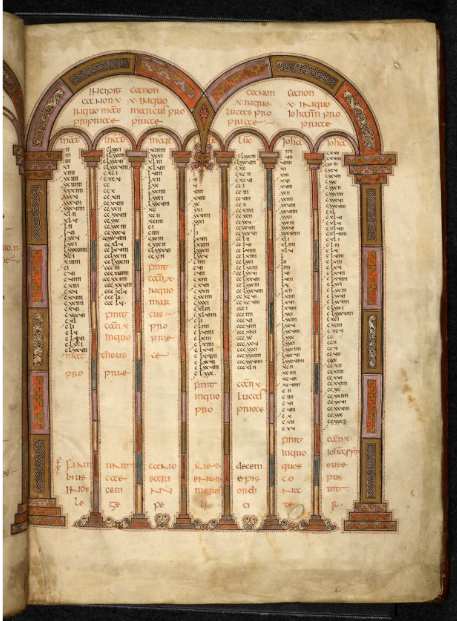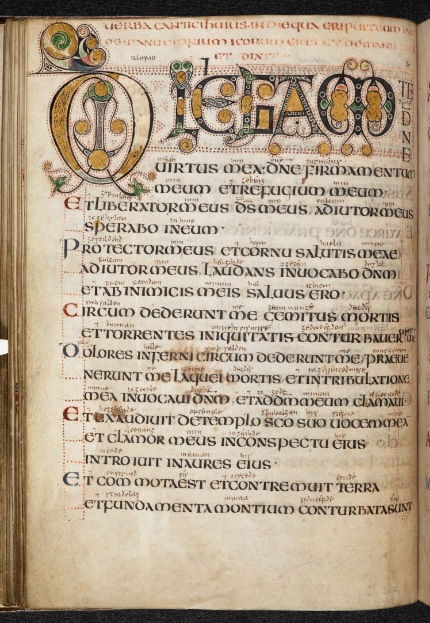Mildred Budny
(Research Group on Manuscript Evidence)
“Variability or Multiple Identities?
A Question of Style, Constraints, and Potential”
Abstract of Paper Presented at the 49th International Congress on Medieval Studies (Kalamazoo, May 2014)
Session on “Individual Style or House Style? Assessing Scribal Contributions, Artistic Production, and Creative Achievements” described here: Sessions at the 2014 Congress
Sponsored by the Research Group on Manuscript Evidence
Organized by Mildred Budny
2014 Congress Accomplished
[First published on our first website on 19 March 2014, with updates both there and here on our second website]
I. The Quest and Its Questions
Perennial in the encounter with materials from the past, near or remote, is the quest to identify the work of individual hands in media of whatever kind, whether signed or unsigned. Particularly challenging may be the cases for which little or no external evidence survives (or is yet recognized), so that the quest must proceed principally on the basis of stylistic features and their analysis, which in practice is more or less rigorous. Such challenging conditions pertain to witnesses from many periods or regions, not least the early Middle Ages. Closely related to these tasks, and often overlapping or combined with them, explicitly or implicitly, is the drive to attribute a given work or body of works to a known individual, named or unnamed, whether acting as scribe, author, annotator, artist, craftsman, teacher, student, patron, designer, or owner. Especially tempting for some practitioners of identifications may be the hope, wish, or determination to accomplish this attribution or authentication where notable figures — including financial valuations — are involved. Well known are the controversies surrounding attributions or re-attributions attached to the names of, for example, Shakespeare or Rembrandt.
With selected cases of identification drawing mainly from early medieval manuscripts (scripts in Latin and the vernacular, decoration, illustration, and layers of accretion provided by different hands), this paper surveys a range of methods currently employed or deployed or ignored in the aim to identify an individual hand, follower, or workshop (or forger thereof) in given works, or fragmentary works, particularly those of distinction, mastery, and sometimes collaborative production. The methods employed in the widespread efforts hold various degrees of precision and confidence levels. Too often some methods are unclarified or garbled, whereby assumptions or wishful thinking may masquerade as valid, appropriate, and rigorous interpretation, even where scientific or forensic techniques are invoked in the examination of the evidence itself. An important part of these problems may reside in the increasingly wide range of disciplines, both humanist and scientific, required for a proper analysis of the materials — including the very substances as well as the textual or visual contents — and in the need to co-ordinate, as well as to understand, the strengths and limitations of the extensive areas of specialization required for integrated scholarly research and substantive results in a digital age.
II. Cases in Point
Cases for consideration include attributions (some controversial or wrongly ignored) concerning the body of work from:
1) The 9th-century Royal Bible Master of St. Augustine’s Abbey, Canterbury — a versatile scribal artist responsible for the medium-format Vespasian Psalter Gloss in Old English (London, British Library, Cotton MS Vespasian A.i), as well as for most of the surviving portions of the large-format Royal Bible (British Library, Royal MS 1 E.vi etc.), with a virtuoso display of different scripts, forms of decoration, and elaborate illustration.

©The British Library Board, Royal MS 1 E vi, folio 6r, with the closing arcade for the Eusebian Canon Tables. Reproduced by permission

© The British Library Board, Cotton MS Vespasian A I, folio 21v, opening of Psalm 17 in Latin, with added interlinear gloss in Old English. Reproduced by permission
2) The 11th-century Artist of the Added Mark Frontispiece in that same Bible, responsible also for
some scenes in
- the Illustrated Old English Hexateuch from St. Augustine’s Abbey (British Library, Cotton MS Claudius B.iv)
and frontispieces in
- the Cotton Bilingual Miscellany (British Library, Cotton MS Tiberius A.iii),
- the Corpus Eremetical Saints’ Lives (Cambridge, Corpus Christi College, MS 389),
- and perhaps the Warsaw Evangelistary and Lectionary (Warsaw, Biblioteka Narodowa, MS I. 3311).
3) The two hands involved in the layered creation of St. Dunstan’s ‘autograph’ and ‘portrait’ (not a self-portrait!) beside an Appearing Christ in the frontispiece of St. Dunstan’s so-called ‘Classbook’ (Oxford, Bodleian Library, Auct. MS F.IV.32).
*****
Follow-Up
Further information about those considered cases can be found here:
1&2. https://www.academia.edu/1833742/British_Library_Manuscript_Royal_1_E.vi_The_Anatomy_of_an_Anglo-Saxon_Bible_Fragment
The full text is available for free via ethos.bl.uk (order no. thesis00342356).
And now a blogpost in the series on Manuscript Studies: The ‘Foundling Hospital’ for Manuscript Fragments
3. https://www.academia.edu/1813135/St_Dunstans_Classbookand_its_Frontispiece_Dunstans_Portrait_and_Autograph.
This essay is viewable via http://www.questia.com/read/63612059/st-dunstan-his-life-times-and-cult.
Some of the manuscripts under consideration are viewable in full digital facsimile, for virtual comparison and detailed examination:
- Vespasian Psalter: http://www.bl.uk/manuscripts/FullDisplay.aspx?ref=Cotton_MS_Vespasian_A_I
- Illustrated Old English Hexateuch: http://www.bl.uk/manuscripts/FullDisplay.aspx?ref=Cotton_MS_Claudius_B_IV
- Cotton Bilingual Miscellany: full facsimile not yet
- Corpus Eremetical Saints’ Lives: http://parkerweb.stanford.edu/parker/actions/page_turner.do?ms_no=389
- Warsaw Evangelistary and Lectionary: full facsimile not yet
- St. Dunstan’s ‘Classbook’: http://image.ox.ac.uk/show?collection=bodleian&manuscript=msauctf432
The increased availability of digital resources, together with time-tested research techniques of close observation, detailed comparison, and rigorous analysis (stylistic, forensic, and more) make it possible to read the academic texts cited here together with the sources to which they refer and which they may illuminate.
*****
Another Abstract by this author appears here: Budny (2015 Congress).
Some further fruits of this process of long-term reflections on the Royal Bible and related issues are reported in our series of blogposts on Manuscript Studies,
as one of the founding posts in the series of blogposts:
The ‘Foundling Hospital’ for Manuscript Fragments.
*****

[…] Mildred Budny (Research Group on Manuscript Evidence), “Variability or Multiple Identities? A Question of Style, Constraints, and Potential” Abstract / Budny (2014 Congress) […]